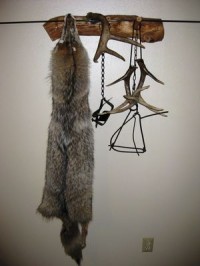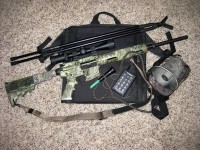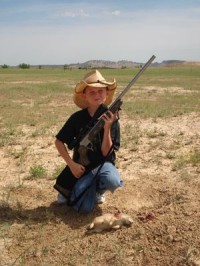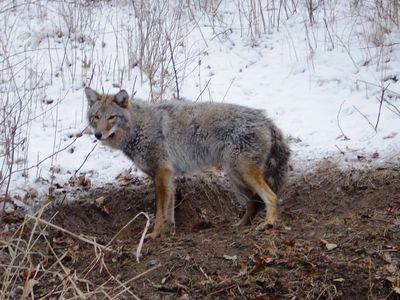Well, the 2008-09 predator hunting season is in the books for me this year. I hunted pretty consistently from mid – December until mid – March, with the loss of snow being a limiting factor in the last few weeks. Overall, I guess I’m pretty happy with this year’s results and thought I’d take some time to think about what made this year more
productive than the last few. Like any other type of hunting I think the best advice is to spend time in the field listening, observing, and experimenting. Here are a few things that I discovered.
 In my first couple of years of coyote hunting I was pretty hesitant to try any different sounds to change things up. This year instead of having one or two primary sounds that I would utilize on my electronic call I used about six or seven sounds pretty consistently. The sounds ranged from the good ‘ol rabbit distress to various coyote vocalizations. Many times I tried using multiple sounds during the same stand taking the advice of the Master, Randy Andersen, trying to create a type of scenario to pique the coyote’s curiousity and hopefully draw them into range. I plan on continuing to experiment with sound selection and hope to add even more sounds to the library for next year. It never hurts to mix things up a little bit.
In my first couple of years of coyote hunting I was pretty hesitant to try any different sounds to change things up. This year instead of having one or two primary sounds that I would utilize on my electronic call I used about six or seven sounds pretty consistently. The sounds ranged from the good ‘ol rabbit distress to various coyote vocalizations. Many times I tried using multiple sounds during the same stand taking the advice of the Master, Randy Andersen, trying to create a type of scenario to pique the coyote’s curiousity and hopefully draw them into range. I plan on continuing to experiment with sound selection and hope to add even more sounds to the library for next year. It never hurts to mix things up a little bit.
 I also did quite a bit of experimenting with different types of shooting sticks and strategies to prepare for shots that could come from virtually anywhere, at any time. What I finally decided was that I let the cover and the situation dictate whether or not I would keep my gun on the shooting sticks for each particular stand. Out of habit I would often get set up to call, set my gun on the bipod, and start the set. I got burned several times at the beginning of the year by having my gun on a bipod that clipped onto my gun versus just laying in a yoke attached to the bipod which allowed me faster shooting options. I remedied the problem by retrofitting a v-shaped yoke to the top of my Stoney Point Rapid Pivot bipod and I’m very happy with the results.
I also did quite a bit of experimenting with different types of shooting sticks and strategies to prepare for shots that could come from virtually anywhere, at any time. What I finally decided was that I let the cover and the situation dictate whether or not I would keep my gun on the shooting sticks for each particular stand. Out of habit I would often get set up to call, set my gun on the bipod, and start the set. I got burned several times at the beginning of the year by having my gun on a bipod that clipped onto my gun versus just laying in a yoke attached to the bipod which allowed me faster shooting options. I remedied the problem by retrofitting a v-shaped yoke to the top of my Stoney Point Rapid Pivot bipod and I’m very happy with the results.
 The last thing that I discovered this year is that coyotes will sometimes take a while to respond to the call. In the past I always stayed at stands for about 20 minutes which is what I had always read in various publications. On at least three occassions I had coyotes respond to the call 30 – 35 minutes after I started calling. On the hunt I titled “Last Minute Yote”, I remember thinking about wrapping up the set but decided that I was pretty comfortable sitting in my Crazy Creek chair and that I would just hang out and watch the landscape for awhile. Sticking around paid off in that case and I ended up shooting a nice female ‘yote that night.
The last thing that I discovered this year is that coyotes will sometimes take a while to respond to the call. In the past I always stayed at stands for about 20 minutes which is what I had always read in various publications. On at least three occassions I had coyotes respond to the call 30 – 35 minutes after I started calling. On the hunt I titled “Last Minute Yote”, I remember thinking about wrapping up the set but decided that I was pretty comfortable sitting in my Crazy Creek chair and that I would just hang out and watch the landscape for awhile. Sticking around paid off in that case and I ended up shooting a nice female ‘yote that night.
Hopefully this was helpful to a few of you who are getting into calling predators and if anyone has any great tips or tactics feel free to share. I try to write myself a few notes and the end of each season as a means of keeping records and to also help keep me from making the same mistakes twice. In the off season I’ll be working on stocking up on reloads for next year and keeping the guns dialed in by getting plenty of practice at the range as well as a Prairie Dog shoot with my son in June. Good luck to all on your future hunts…
2008-09 Predator Season Results
Coyotes Called – 16
Fox Called – 1
Coyotes Killed – 9
Coyotes Missed by me – 5
Coyotes Missed by partner – 2
Author: Jeff Hansen (aka: str8shooter )
Posted via:

Nice end of the season recap str8shooter!

Man, were you on those yotes this year.
 Congrats on a great season and I’m looking forward to seeing what happens next year for ya. Keep up the good work and keep pounding those yotes!
Congrats on a great season and I’m looking forward to seeing what happens next year for ya. Keep up the good work and keep pounding those yotes! 
I’m sure most of you guys read his reports and seen Jeff’s (str8shooter) pictures this past Winter. We had asked Jeff, if he would write up a recap of his Predator Hunting season for us so we could post here for the benefit of everyone here. He did not disappoint, nicely done Jeff!
9 FOR 16… That’s one heck of a batting average!
That’s one heck of a batting average!  Nice report and we look forward to next seasons updates as well! To be honest I’ve never tried predator hunting before…but like turkey hunting I suppose, if I go just once I’ll probably be hooked!
Nice report and we look forward to next seasons updates as well! To be honest I’ve never tried predator hunting before…but like turkey hunting I suppose, if I go just once I’ll probably be hooked! 
Excellent recap Jeff and congratulations on a stellar predator year!
I have a few questions for you:
What do you use for a predator gun/scope and why?
What do you do in regard to keeping your scent under control and how does scent/wind play into your hunts?
What do you carry with you when you hunt predators?
How much scouting do you do?
thanks, guys… I appreciate the comments.
Brad,
I’ve used several different gun/ scope combos in the past, but the gun I currently like most for calling is the Remington R-15 Carbine in .223. The gun is amazingly accurate for an autoloader and the fast follow up shots are great when the action gets fast and furious. I topped it with a Burris 3-9×40 with an illuminated dot reticle. I really like the illuminated reticle for those low light periods. After shooting a red dot sight on a .22 pistol for quite a few years I’ve found that I keep both eyes open and target aquisition is pretty automatic.
As far as scent control is concerned I just try to play the wind much like you would while bowhunting. I try to approach stand locations with a route that won’t draw attention to me as well as keeping my scent cone from being carried into the cover that I’m calling to. I generally call towards cover from downwind or crosswind. Lately, I’ve been making more sets from a crosswind location so that I can keep a better eye on the downwind. This is especially helpful if you’re hunting alone.
While traveling to set locations I try to keep things very simple. I have a few select items that I carry with on each set and everything has a purpose:
– R-15 (or firearm of choice)
– Minaska Electronic Call
– Remote on lanyard w/ a howler and back up mouth call
– Crazy Creek Chair (a great back saver)
– Shooting Sticks
– Small flashlight
– Parachute cord (for dragging)
Scouting stand locations is an important component to success. I have found that most any farm that I’ve walked on has coyote tracks, but a quick walk of a property will show you concentrations of activity. It could be a brushy thicket that gets hunted hard by coyotes or a travel route along a ridgeline. Many times the landowner is a great source of information and can tell me a lot about the current coyote population and their habits.
hope this helps…